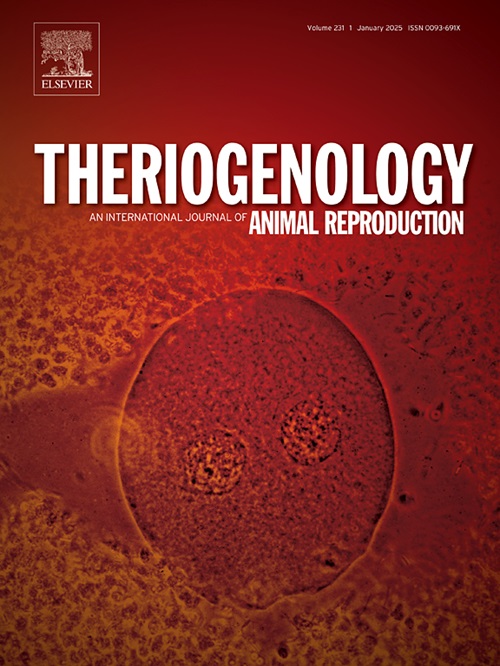正常和异常幼犬胎盘的组织学改变:与新生儿结局和胎儿健康的相关性
IF 2.4
2区 农林科学
Q3 REPRODUCTIVE BIOLOGY
引用次数: 0
摘要
鉴于组织学评估是识别胎盘改变可能与先天性和新生儿异常相关的关键方法,本研究评估了三组幼崽的89个胎盘的组织学改变:Gelet(选择性剖腹产,有健康的后代),GDist(治疗性剖腹产,有健康的后代)和GAnom(死产或胎儿异常,无论剖腹产类型)。评估胎盘是否存在充血、出血、炎症浸润、坏死和钙化,并对这些改变进行分级:0 -无改变,1 -受影响区域高达25%,2 -受影响区域高达50%,3 -受影响区域高达75%。组织学分析显示各组的变化程度不同,其中GAnom组的变化最为显著。只有19%的GAnom胎盘是正常的,而81%的胎盘表现出明显的改变,如1级、2级和3级出血,经常伴有坏死和炎症浸润。统计分析显示,各组幼犬和胎盘重量差异无统计学意义(p >;0.1),但GAnom组的Apgar评分明显较低(p <;0.001)。胎盘改变的类型与幼犬健康之间存在显著相关性,异常幼犬3级出血的发生率增加(p <;0.001)和2级坏死(29% vs.正常组6%;p = 0.0002)。在正常幼鼠中,坏死的存在与Apgar评分呈负相关(p = 0.02),表明其对新生儿结局的潜在影响。这些发现强调了严重的胎盘改变和不良胎儿结局之间的重要联系,强调了进一步研究这些变化背后机制的必要性。本文章由计算机程序翻译,如有差异,请以英文原文为准。
Histological alterations in placentas of normal and anomalous pups: correlation with neonatal outcomes and fetal health
Given that histological evaluation is a key method for identifying placental alterations potentially linked to congenital and neonatal abnormalities, this study evaluates histological alterations in 89 placentas from pups across three groups: Gelet (elective c-sections with healthy offspring), GDist (therapeutic c-sections with healthy offspring), and GAnom (stillborn offspring or those with fetal abnormalities, regardless of the type of c-section). The placentas were evaluated for the presence of congestion, hemorrhage, inflammatory infiltrate, necrosis, and calcification, and these alterations were graded on a scale: 0 – no alterations, 1 – up to 25 % of the region affected, 2 – up to 50 % affected, and 3 – up to 75 % affected. Histological analysis revealed varying degrees of alterations across groups, with the GAnom group exhibiting the most significant changes. Only 19 % of GAnom placentas were normal, while 81 % displayed notable alterations such as grade 1, 2 and 3 hemorrhage, frequently accompanied by necrosis and inflammatory infiltrates. Statistical analysis showed no significant difference in pup and placenta weights among groups (p > 0.1), but Apgar scores were considerably lower in the GAnom group (p < 0.001). A significant correlation was found between the type of placental alteration and pup health, with anomalous pups showing increased incidences of grade 3 hemorrhage (p < 0.001) and grade 2 necrosis (29 % vs. 6 % in the normal group; p = 0.0002). The presence of necrosis negatively correlated with Apgar scores in normal pups (p = 0.02), indicating its potential impact on neonatal outcomes. These findings highlight the critical association between severe placental alterations and adverse fetal outcomes, emphasizing the need for further investigation into the mechanisms underlying these changes.
求助全文
通过发布文献求助,成功后即可免费获取论文全文。
去求助
来源期刊

Theriogenology
农林科学-生殖生物学
CiteScore
5.50
自引率
14.30%
发文量
387
审稿时长
72 days
期刊介绍:
Theriogenology provides an international forum for researchers, clinicians, and industry professionals in animal reproductive biology. This acclaimed journal publishes articles on a wide range of topics in reproductive and developmental biology, of domestic mammal, avian, and aquatic species as well as wild species which are the object of veterinary care in research or conservation programs.
 求助内容:
求助内容: 应助结果提醒方式:
应助结果提醒方式:


